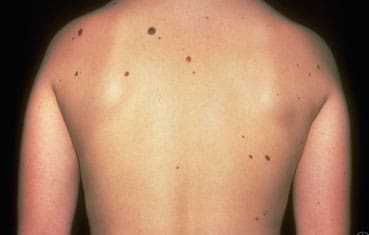Atypical Nevi
Understanding Atypical Nevi
Do you have a mole that is much larger than the other moles on your body? These are probably atypical nevi, also known as dysplastic nevi. These are moles that aren’t skin cancer but could be a risk factor associated with developing melanoma.

So, how well do you really know your skin? Although these moles are benign, they are worth paying attention to. Here’s the best advice: make sure you know what your moles look like, so you’ll be able to tell your dermatologist if there are any changes.
What are Atypical Nevi?
Atypical moles mostly occur on the upper back, torso, lower legs, head, and neck. While these are the most common areas for these moles to appear, atypical nevi have also been known to pop up anywhere on the body, including the feet, hands, scalp, and the genital area.
If you have these moles, you must be extra careful about other common melanoma risk factors like:
- Fair skin, light eyes, or hair
- Freckles
- Many moles
- A family history of melanoma
- Photosensitivity
- Inability to tan
- Multiple sunburns
Although it is rare, melanoma can arise in association with atypical moles. That’s why it is important to pay close attention to these moles and get them checked by your dermatologist.
The ABCDE Warning Signs of Atypical Nevi
Some people may have one or a few atypical moles, but it is not uncommon for someone to have many of them all over their body. So, how can you tell if these moles are anything to worry about? You can follow the first five letters of the alphabet as a guide for warning signs.
- A is for Asymmetry
Most melanomas are asymmetrical. So, for a worrisome mole, if you draw a line down the center, the two sides will not look the same. - B is for Border
Pay close attention to the borders. Borders tend to be uneven and may have a scalloped or notched edge. Common moles tend to have smoother, even borders. - C is for Color
Multiple colors are a warning sign. Moles that are benign will usually have a single shade of brown or a tan or black shade. - D is for Diameter and Dark
If the lesion is about the size of a pencil eraser, that is a warning sign. Also, the lesion will be darker than others, no matter what size it is. - E is for Evolving
Any sort of change in your mole is a big warning sign. This includes a change in size, color, shape, or elevation.
Related Pages
- Treatment for Flaky Facial Skin from Dandruff and Rosacea
- Glytone
- Avene
- Microblading vs. Eyebrow Tattooing: What’s the Difference, and Why Does it Matter?
- Forehead Botox: Everything You Need to Know about the Cost, Risks, and Benefits
- Bellafill: A Long-Lasting, Effective Dermal Filler Solution
- Sebaceous Hyperplasia: Causes, Symptoms, and Treatment
- Laser Hair Removal: The Superior Alternative
- Neck Lift
- Wrinkle Treatment
- Molluscum
- Seborrheic Keratosis
- Mole Removal
- Actinic Keratosis
- Contact Dermatitis
- Itchy Scalp Treatment
- Atypical Nevi
- Hyperhidrosis Treatment
- Melasma Treatment
- Cysts Treatment
- Psoriasis
- Warts Treatment
- Eczema Treatment
- Seborrheic Dermatitis Treatment
- Rosacea Treatment
- Fungal Infections
- Hair Loss Treatment
- Acne Treatment
Quick Quote
Causes for Atypical Nevi
Scientists and researchers aren’t exactly sure what causes these moles. They are still trying to understand and determine the cause. However, they do believe that a combination of genetic and environmental factors, like sunlight, is responsible for atypical moles.
What is Atypical Mole Syndrome?
People with atypical mole syndrome are at an especially high risk of developing melanoma. You can be diagnosed with atypical mole syndrome if you have:
- 100 or more moles
- One or more moles 1/3 inch or larger in diameter
- One or more atypical moles
If you have hereditary risk factors for melanoma as well as many atypical moles, you may be classified as having Familial Atypical Multiple Mole Melanoma Syndrome (FAMMM). FAMMM is an inherited condition characterized by the presence of multiple moles. This puts you at an even higher risk of developing melanoma.
Atypical Nevi Treatment
Talk to your dermatologist about any abnormal features your mole may have. Frequently monitoring your moles and doing a self-examine is crucial for catching melanoma early and getting it treated.
If your doctor thinks a mole is suspicious, or if you have new moles that appear over the age of 40, you may need a biopsy.
Atypical moles may be removed if:
- A patient has a high-risk history
- A patient cannot guarantee close follow-up
- The mole has a high-risk dermatoscopic findings
- The mole is in a location that makes monitoring the lesion difficult
What Can You Do About Atypical Moles?
The most important thing you can do about atypical moles is to know your skin. Perform monthly self-checks and visit your dermatologist regularly.
Be sure to pay close attention to:
- changes in sizes, color, or texture of a mole
- moles that begin itching, bleeding, crusting, oozing, or swelling
- If your mole becomes painful
Protect yourself against UV rays. You can reduce your skin cancer risk by using sunscreen daily and wearing protective clothing and hats, even when it is cloudy outside. You can also minimize your sun exposure by staying out of the tanning bed and minimizing the time you spend outdoors between 10:00 AM and 2:00 PM when the sun is the strongest.
Let Winston Salem Dermatology Examine Your Skin
Don’t ignore a suspicious-looking mole. Get it looked at by the skin experts at Winston Salem Dermatology. We are a group of reliable dermatologists that you can trust with your skin. Not only do we provide our patients with a variety of treatment options, but we also provide the best support system and after-care. No matter what your needs may be, we are here for you at Winston Salem Dermatology. Give us a call today at (336) 774-8636 to book your first appointment.
Related Pages
- Treatment for Flaky Facial Skin from Dandruff and Rosacea
- Glytone
- Avene
- Microblading vs. Eyebrow Tattooing: What’s the Difference, and Why Does it Matter?
- Forehead Botox: Everything You Need to Know about the Cost, Risks, and Benefits
- Bellafill: A Long-Lasting, Effective Dermal Filler Solution
- Sebaceous Hyperplasia: Causes, Symptoms, and Treatment
- Laser Hair Removal: The Superior Alternative
- Neck Lift
- Wrinkle Treatment
- Molluscum
- Seborrheic Keratosis
- Mole Removal
- Actinic Keratosis
- Contact Dermatitis
- Itchy Scalp Treatment
- Atypical Nevi
- Hyperhidrosis Treatment
- Melasma Treatment
- Cysts Treatment
- Psoriasis
- Warts Treatment
- Eczema Treatment
- Seborrheic Dermatitis Treatment
- Rosacea Treatment
- Fungal Infections
- Hair Loss Treatment
- Acne Treatment
Quick Quote
Address
Winston Salem Dermatology & Surgery Center
1400 Westgate Center Drive,
Suite 200 - Winston Salem, NC 27103
Phone: 336.774.8636
Fax: 336.774.0265
www.WinstonSalemDermatology.com



